Formation of the Liaotianshan Volcano in Southeastern China: Implications for the Evolution and Recharge of Crustal Magma System
Abstract
1. Introduction
2. Geological Background
3. Samples and Methods
4. Results
4.1. Zircon U–Pb Geochronology
4.2. Zircon Trace Elements
4.3. Zircon Hf Isotopes
4.4. Whole-Rock Major and Trace Elements
5. Discussion
5.1. Affinities of the Zircons and Their Constraints on the Timescale of the Volcanic Activity
5.2. Evolution and Replenishment of the Magma
5.3. Petrogenesis of the Extrusive Rhyolite Porphyries
6. Conclusions
Supplementary Materials
Author Contributions
Funding
Data Availability Statement
Acknowledgments
Conflicts of Interest
References
- Keller, C.B.; Schoene, B.; Barboni, M.; Samperton, K.M.; Husson, J.M. Volcanic–plutonic parity and the differentiation of the continental crust. Nature 2015, 523, 301–307. [Google Scholar] [CrossRef] [PubMed]
- Lipman, P.W.; Bachmann, O. Ignimbrites to batholiths: Integrating perspectives from geological, geophysical, and geochronological data. Geosphere 2015, 11, 705–743. [Google Scholar] [CrossRef]
- Cashman, K.V.; Sparks, R.S.J.; Blundy, J.D. Vertically extensive and unstable magmatic systems: A unified view of igneous processes. Science 2017, 355, eaag3055. [Google Scholar] [CrossRef] [PubMed]
- Lipman, P.W. The roots of ash flow calderas in western North America: Windows into the tops of granitic batholiths. J. Geophys. Res. Solid Earth 1984, 89, 8801–8841. [Google Scholar] [CrossRef]
- Bachmann, O.; Miller, C.F.; de Silva, S.L. The volcanic–plutonic connection as a stage for understanding crustal magmatism. J. Volcanol. Geotherm. Res. 2007, 167, 1–23. [Google Scholar] [CrossRef]
- Jellinek, A.M.; DePaolo, D.J. A model for the origin of large silicic magma chambers: Precursors of caldera-forming eruptions. Bull. Volcanol. 2003, 65, 363–381. [Google Scholar] [CrossRef]
- Glazner, A.F.; Bartley, J.M.; Coleman, D.S.; Gray, W.; Taylor, R.Z. Are plutons assembled over millions of years by amalgamation from small magma chambers? GSA Today 2004, 14, 4–12. [Google Scholar] [CrossRef]
- Tappa, M.J.; Coleman, D.S.; Mills, R.D.; Samperton, K.M. The plutonic record of a silicic ignimbrite from the Latir volcanic field, New Mexico. Geochem. Geophys. Geosyst. 2011, 12, Q10011. [Google Scholar] [CrossRef]
- Yan, L.-L.; He, Z.-Y.; Jahn, B.-M.; Zhao, Z.-D. Formation of the Yandangshan volcanic–plutonic complex (SE China) by melt extraction and crystal accumulation. Lithos 2016, 266–267, 287–308. [Google Scholar] [CrossRef]
- Zhou, X.; Sun, T.; Shen, W.; Shu, L.; Niu, Y. Petrogenesis of Mesozoic granitoids and volcanic rocks in south China: A response to tectonic evolution. Episodes 2006, 29, 26–33. [Google Scholar] [CrossRef]
- Liu, J.-X.; Wang, S.; Wang, X.-L.; Du, D.-H.; Xing, G.-F.; Fu, J.-M.; Chen, X.; Sun, Z.-M. Refining the spatio-temporal distributions of Mesozoic granitoids and volcanic rocks in SE China. J. Asian Earth Sci. 2020, 201, 104503. [Google Scholar] [CrossRef]
- Du, D.H.; Wang, X.L.; Wang, S.; Miller, C.F.; Xu, X.S.; Chen, X.; Zhang, F.F. Deciphering Cryptic Multi-Stage Crystal-Melt Separation during Construction of the Tonglu Volcanic–Plutonic Complex, SE China. J. Petrol. 2022, 63, egab098. [Google Scholar] [CrossRef]
- Xu, X.S.; Zhao, K.; He, Z.Y.; Liu, L. Cretaceous volcanic–plutonic magmatism in SE China and a genetic model. Lithos 2021, 402–403, 105728. [Google Scholar] [CrossRef]
- Liu, L.; Zhao, Y.; He, Z.Y.; Sun, J.; Liu, X.J.; Zhao, Z.X. Activity process and petrogenesis of Liaotianshan caldera in SW Fujian: Evidence from zircon U-Pb, Hf isotopic and trace element concentrations. Acta Geol. Sin. 2023, 97, 2176–2194, (In Chinese with English abstract). [Google Scholar] [CrossRef]
- Chen, J.F.; Jahn, B.M. Crustal evolution of southeastern China: Nd and Sr isotopic evidence. Tectonophysics 1998, 284, 101–133. [Google Scholar] [CrossRef]
- Yu, J.-H.; O’Reilly, S.Y.; Griffin, W.L.; Zhou, M.-F.; Wang, L.-J. U–Pb geochronology and Hf–Nd isotopic geochemistry of the Badu Complex, Southeastern China: Implications for the Precambrian crustal evolution and paleogeography of the Cathaysia Block. Precambrian Res. 2012, 222–223, 424–449. [Google Scholar] [CrossRef]
- Yan, L.-L.; He, Z.-Y.; Beier, C.; Klemd, R. Zircon trace element constrains on the link between volcanism and plutonism in SE China. Lithos 2018, 320–321, 28–34. [Google Scholar] [CrossRef]
- Liu, Y.; Gao, S.; Hu, Z.; Gao, C.; Zong, K.; Wang, D. Continental and Oceanic Crust Recycling-induced Melt–Peridotite Interactions in the Trans-North China Orogen: U–Pb Dating, Hf Isotopes and Trace Elements in Zircons from Mantle Xenoliths. J. Petrol. 2010, 51, 537–571. [Google Scholar] [CrossRef]
- He, Z.-Y.; Yan, L.-L. Zircon trace element geochemistry constrains on the silicic volcanic system. Acta Petrol. Mineral. 2021, 40, 939–951, (In Chinese with English abstract). [Google Scholar]
- Zou, X.; Jiang, J.; Qin, K.; Zhang, Y.; Yang, W.; Li, X. Progress in the principle and application of zircon trace element. Acta Petrol. Sin. 2021, 37, 985–999, (In Chinese with English abstract). [Google Scholar] [CrossRef]
- Anders, E.; Grevesse, N. Abundances of the elements: Meteoritic and solar. Geochim. Cosmochim. Acta 1989, 53, 197–214. [Google Scholar] [CrossRef]
- Xu, X.S.; O’Reilly, S.Y.; Griffin, W.L.; Wang, X.L.; Pearson, N.J.; He, Z.Y. The crust of Cathaysia: Age, assembly and reworking of two terranes. Precambrian Res. 2007, 158, 51–78. [Google Scholar] [CrossRef]
- Middlemost, E.A.K. Naming materials in the magma/igneous rock system. Earth-Sci. Rev. 1994, 37, 215–224. [Google Scholar] [CrossRef]
- McDonough, W.F.; Sun, S.-S. The composition of the Earth. Chem. Geol. 1995, 120, 223–253. [Google Scholar] [CrossRef]
- Coleman, D.S.; Gray, W.; Glazner, A.F. Rethinking the emplacement and evolution of zoned plutons: Geochronologic evidence for incremental assembly of the Tuolumne intrusive suite, California. Geology 2004, 32, 433–436. [Google Scholar] [CrossRef]
- Ma, C.Q.; Li, Y.Q. Incremental growth of granitoid plutons and highly crystalline magmatic differentiation. Acta Petrol. Sin. 2017, 33, 1479–1488, (In Chinese with English abstract). [Google Scholar]
- Simon, J.I.; Renne, P.R.; Mundil, R. Implications of pre-eruptive magmatic histories of zircons for U–Pb geochronology of silicic extrusions. Earth Planet. Sci. Lett. 2008, 266, 182–194. [Google Scholar] [CrossRef]
- Hoskin, P.W.O.; Schaltegger, U. The Composition of Zircon and Igneous and Metamorphic Petrogenesis. Rev. Mineral. Geochem. 2003, 53, 27–62. [Google Scholar] [CrossRef]
- Scaillet, B.; Holtz, F.; Pichavant, M. Experimental constraints on the formation of silicic magmas. Elements 2016, 12, 109–114. [Google Scholar] [CrossRef]
- Medlin, C.; Jowitt, S.; Cas, R.; Smithies, R.; Kirkland, C.; Maas, R.; Raveggi, M.; Howard, H.; Wingate, M. Petrogenesis of the A-type, Mesoproterozoic intra-caldera rheomorphic Kathleen ignimbrite and comagmatic Rowland suite intrusions, West Musgrave Province, Central Australia: Products of extreme fractional crystallization in a failed rift setting. J. Petrol. 2015, 56, 493–525. [Google Scholar] [CrossRef]
- Ustunisik, G.; Kilinc, A. The role of fractional crystallization, magma recharge, and magma mixing in the differentiation of the Small Hasandag volcano, Central Anatolia, Turkey. Lithos 2011, 125, 984–993. [Google Scholar] [CrossRef]
- Humphreys, M.C.; Blundy, J.D.; Sparks, R.S.J. Magma evolution and open-system processes at Shiveluch Volcano: Insights from phenocryst zoning. J. Petrol. 2006, 47, 2303–2334. [Google Scholar] [CrossRef]
- Tepley, F.J.; Davidson, J.P.; Tilling, R.L.; Arth, J.G. Magma mixing, recharge and eruption histories recorded in plagioclase phenocrysts from El Chichon Volcano, Mexico. J. Petrol. 2000, 41, 1397–1411. [Google Scholar] [CrossRef]
- Bachmann, O.; Bergantz, G.W. On the origin of crystal-poor rhyolites: Extracted from batholithic crystal mushes. J. Petrol. 2004, 45, 1565–1582. [Google Scholar] [CrossRef]
- Deering, C.D.; Bachmann, O.; Vogel, T.A. The Ammonia Tanks Tuff: Erupting a melt rich rhyolite cap and its remobilized crystal cumulate. Earth Planet. Sci. Lett. 2011, 310, 518–525. [Google Scholar] [CrossRef]
- Guo, F.; Fan, W.; Li, C.; Zhao, L.; Li, H.; Yang, J. Multi-stage crust–mantle interaction in SE China: Temporal, thermal and compositional constraints from the Mesozoic felsic volcanic rocks in eastern Guangdong-Fujian provinces. Lithos 2012, 150, 62–84. [Google Scholar] [CrossRef]
- He, Z.-Y.; Xu, X.-S. Petrogenesis of the Late Yanshanian mantle-derived intrusions in southeastern China: Response to the geodynamics of paleo-Pacific plate subduction. Chem. Geol. 2012, 328, 208–221. [Google Scholar] [CrossRef]
- Jackson, M.D.; Blundy, J.; Sparks, R.S.J. Chemical differentiation, cold storage and remobilization of magma in the Earth’s crust. Nature 2018, 564, 405–409. [Google Scholar] [CrossRef] [PubMed]
- Annen, C.; Blundy, J.D.; Sparks, R.S.J. The genesis of intermediate and silicic magmas in deep crustal hot zones. J. Petrol. 2006, 47, 505–539. [Google Scholar] [CrossRef]
- Gualda, G.A.; Ghiorso, M.S. Low-pressure origin of high-silica rhyolites and granites. J. Geol. 2013, 121, 537–545. [Google Scholar] [CrossRef]
- Ferry, J.M.; Watson, E.B. New thermodynamic models and revised calibrations for the Ti-in-zircon and Zr-in-rutile thermometers. Contrib. Mineral. Petrol. 2007, 154, 429–437. [Google Scholar] [CrossRef]
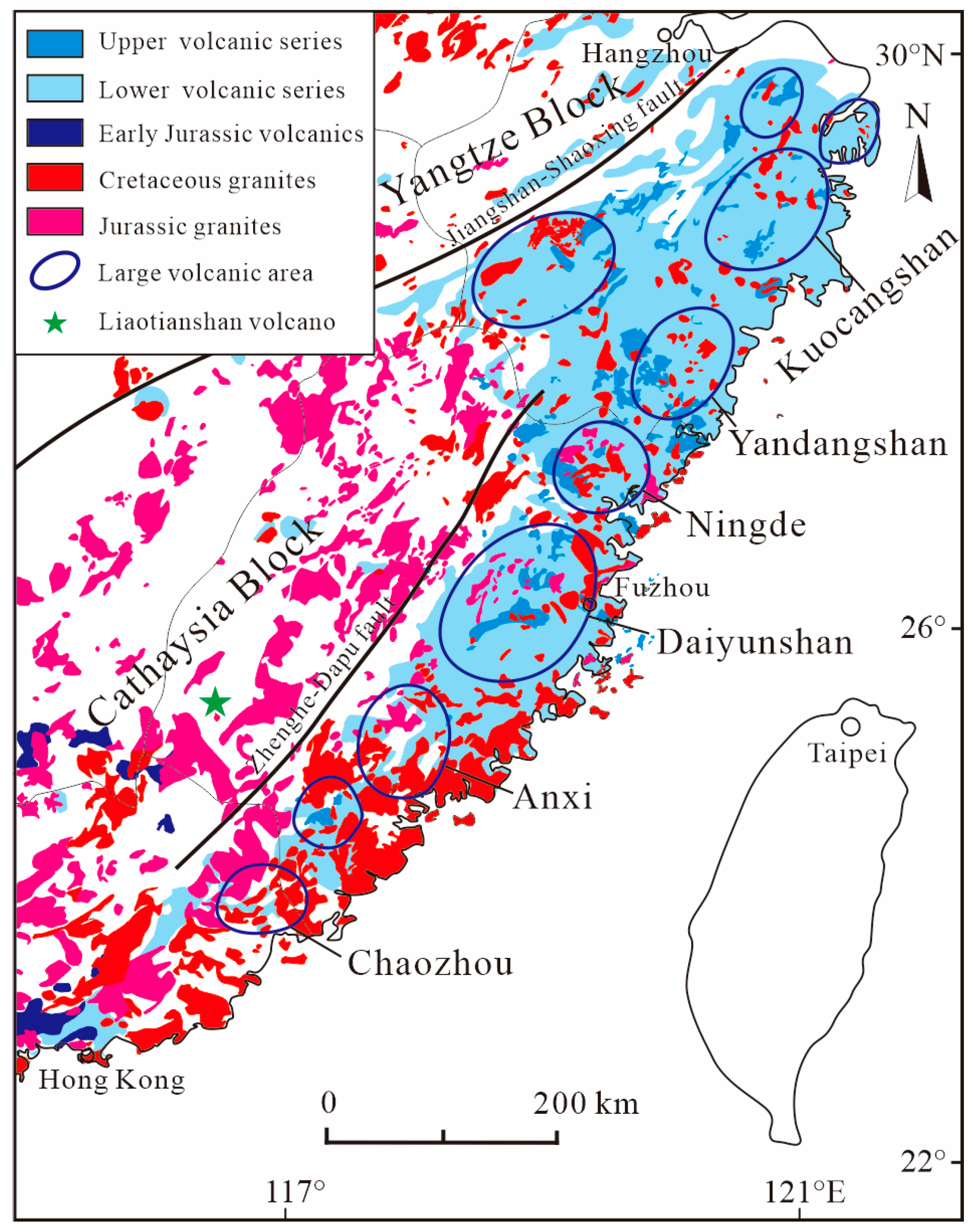
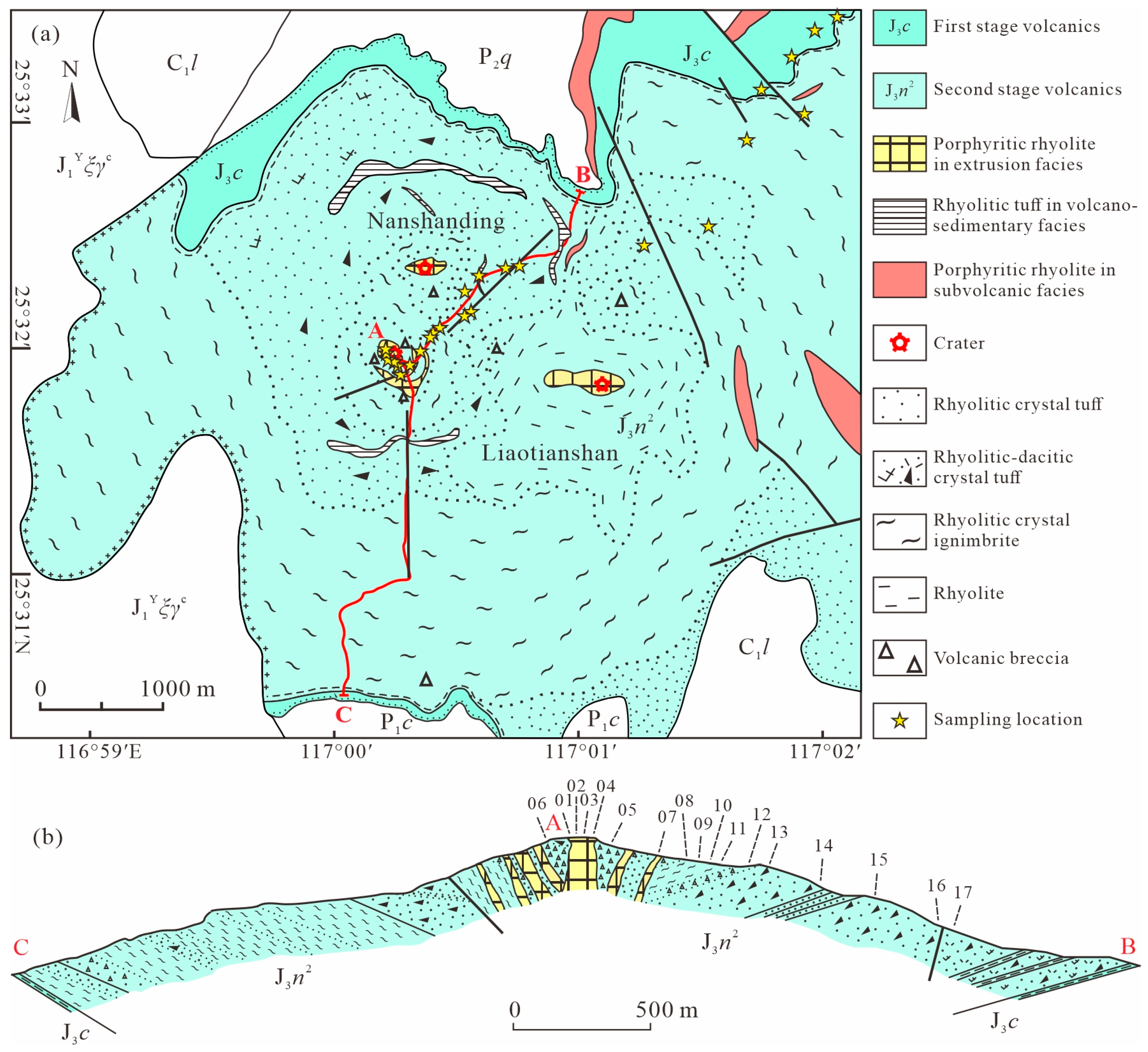
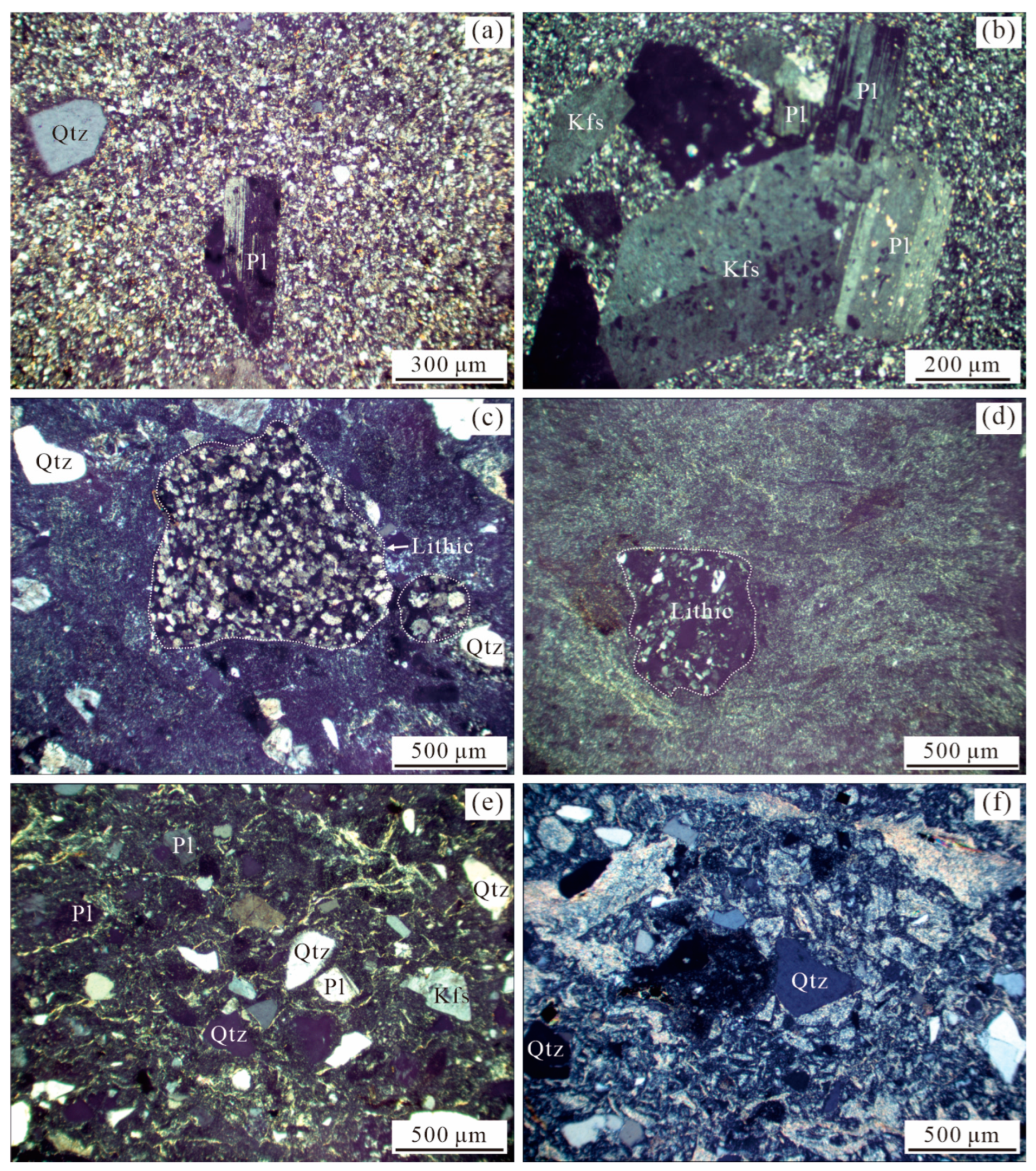
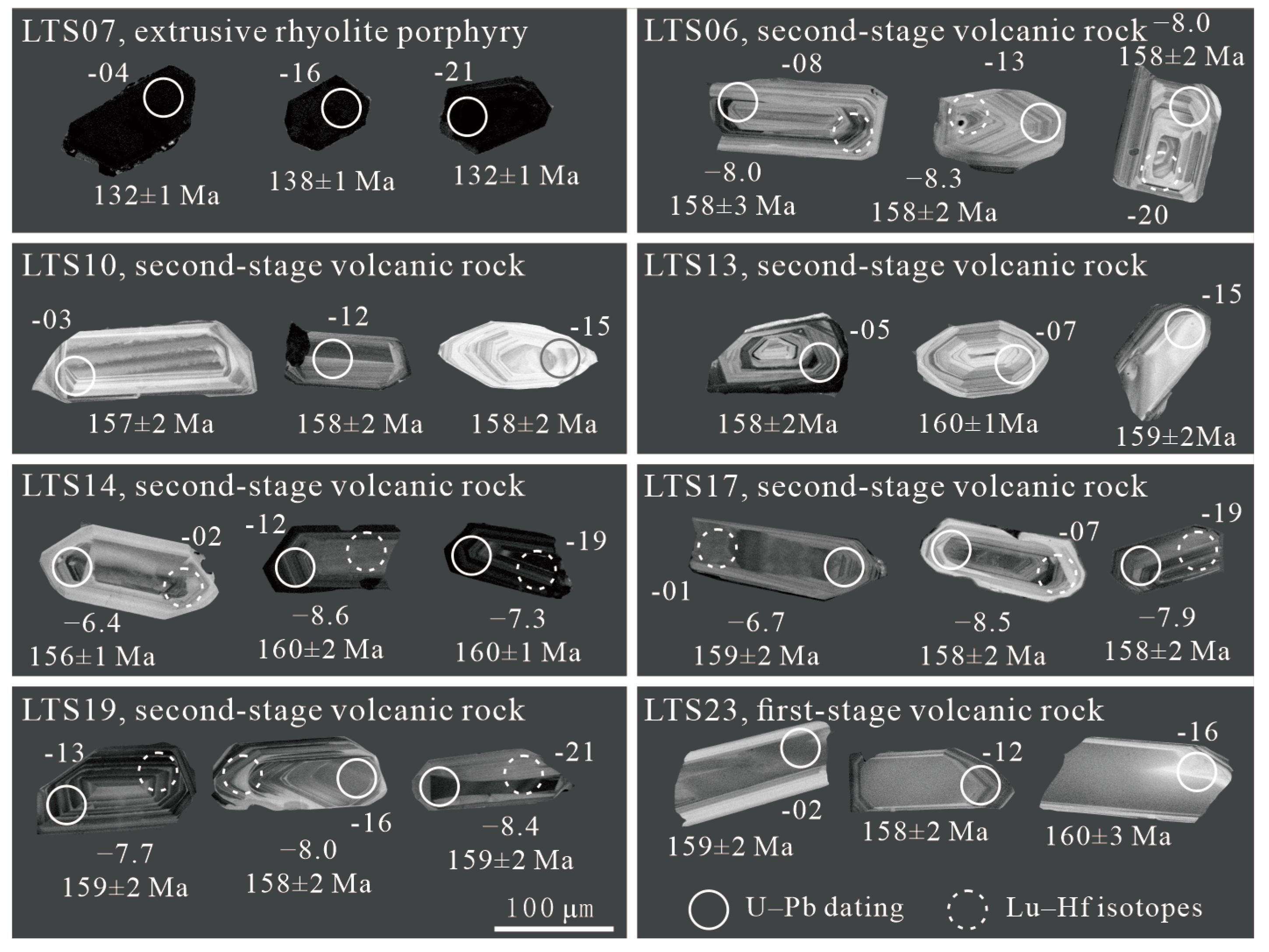
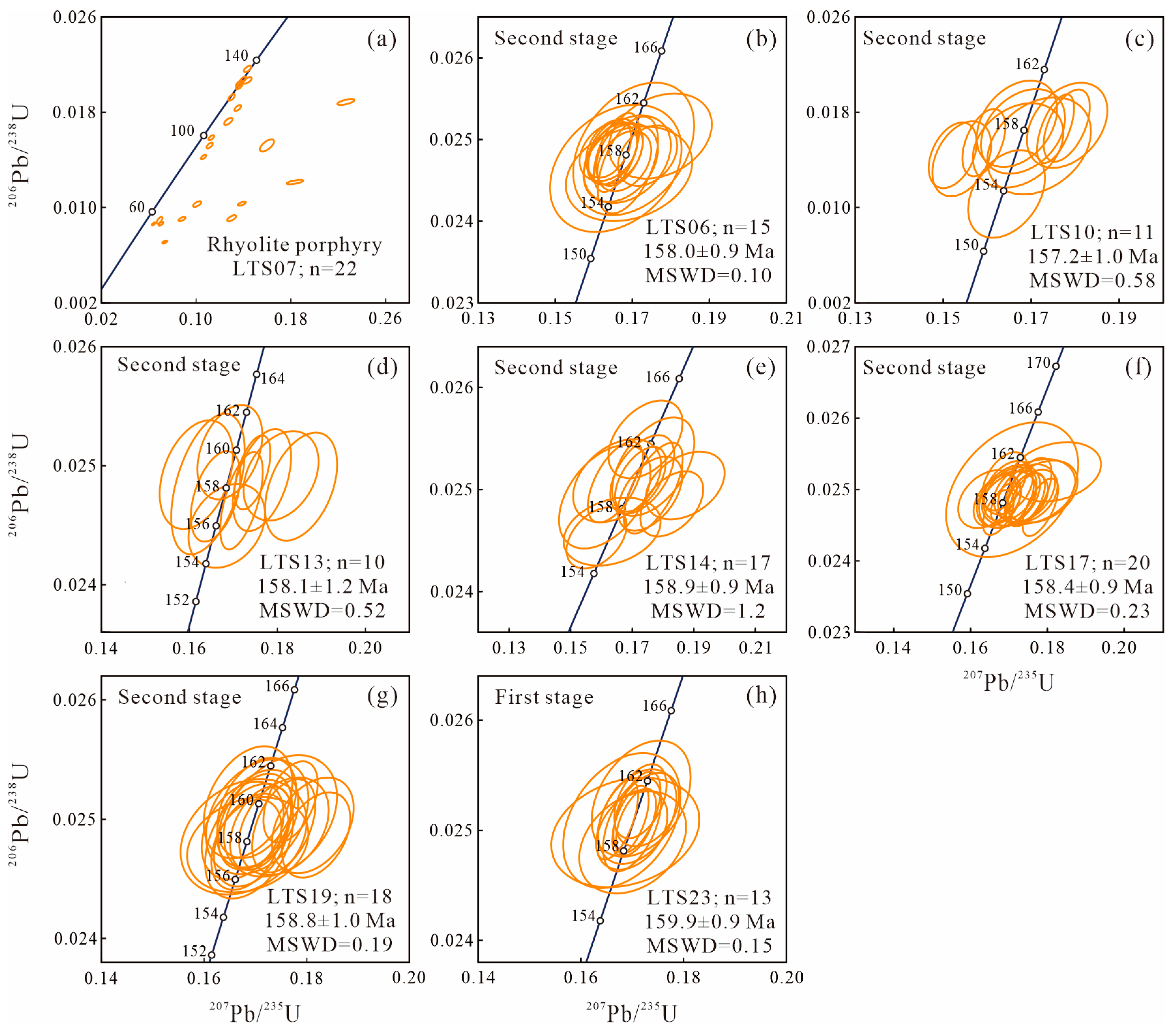

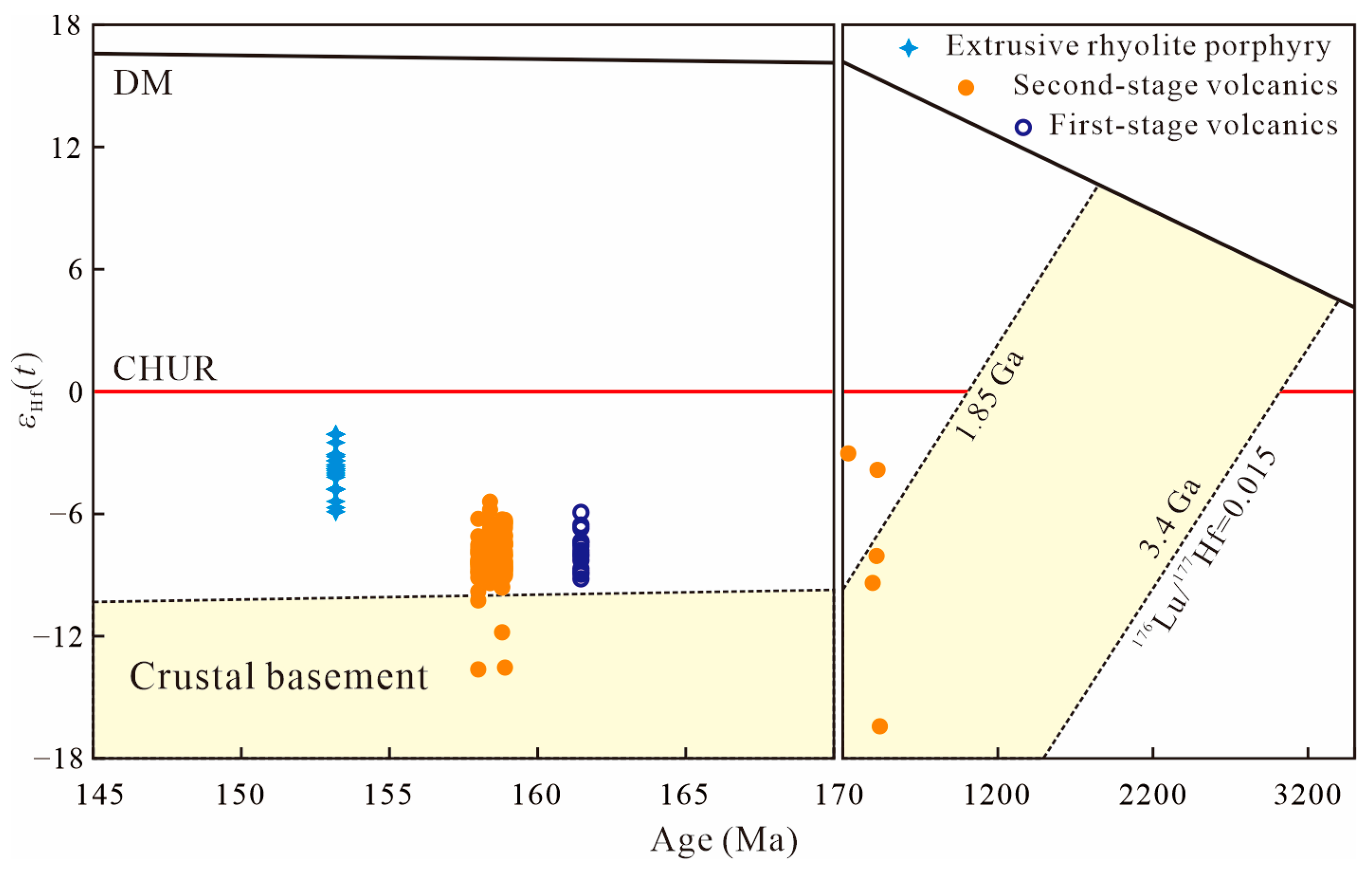


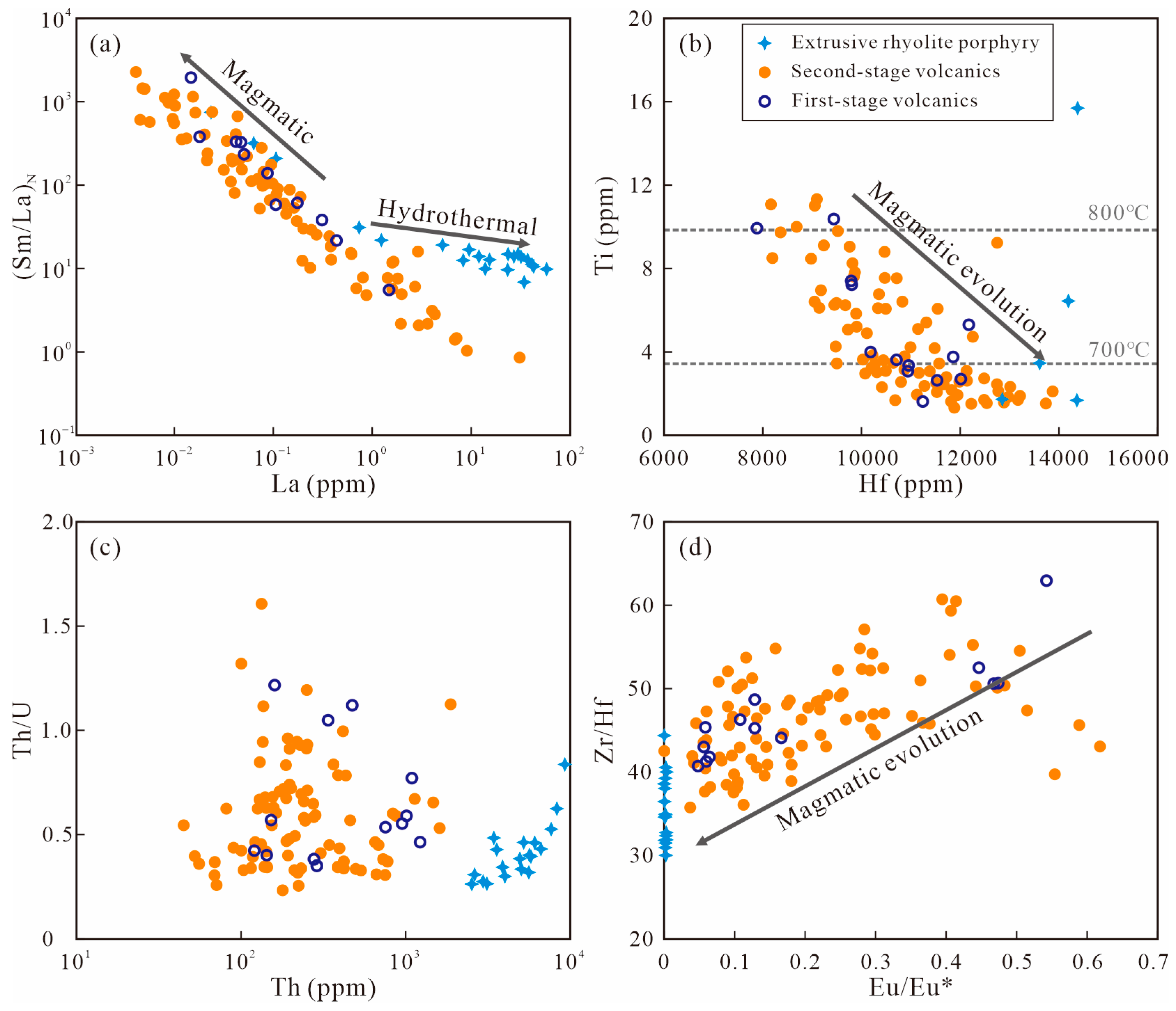

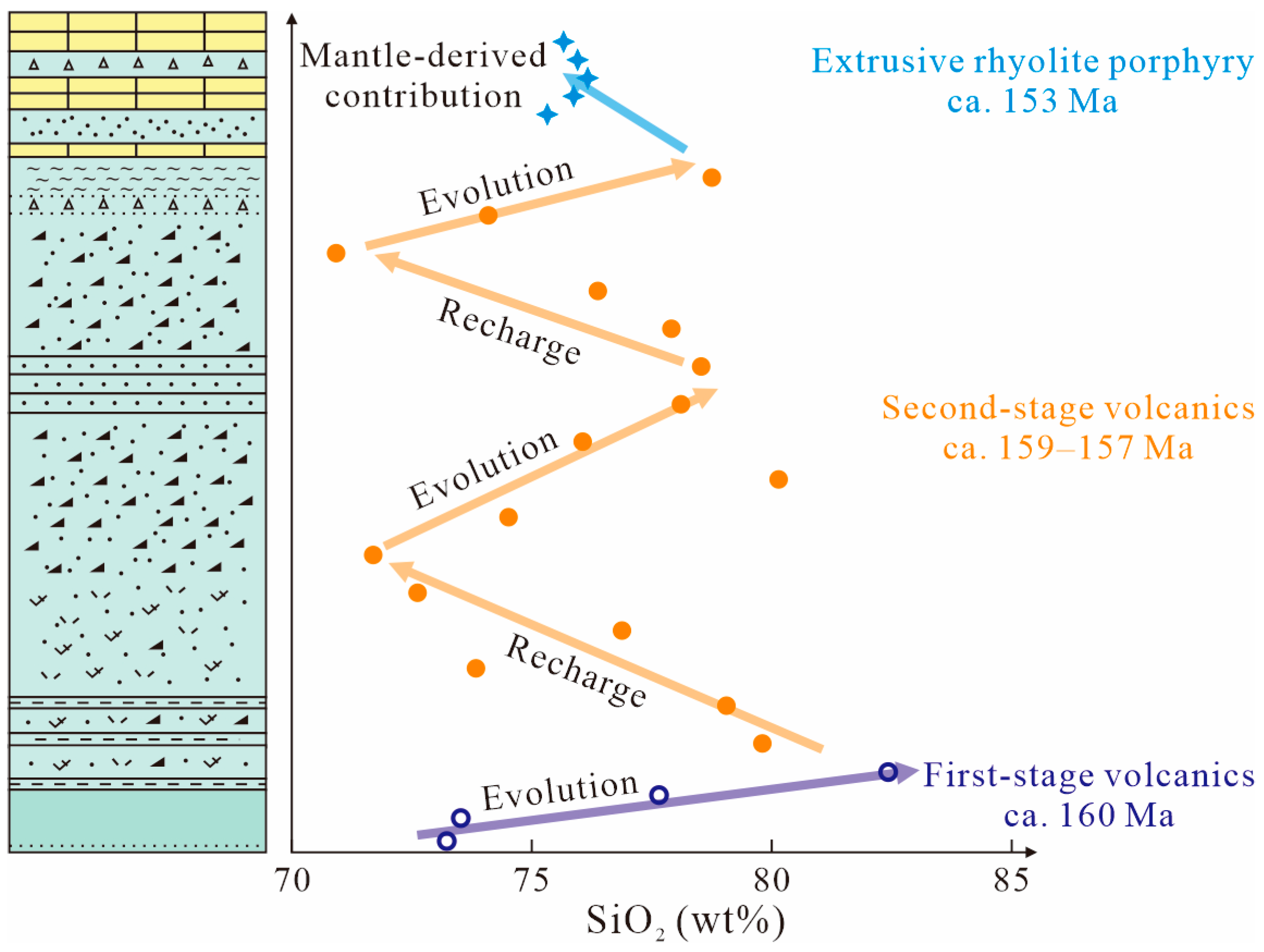
Disclaimer/Publisher’s Note: The statements, opinions and data contained in all publications are solely those of the individual author(s) and contributor(s) and not of MDPI and/or the editor(s). MDPI and/or the editor(s) disclaim responsibility for any injury to people or property resulting from any ideas, methods, instructions or products referred to in the content. |
© 2024 by the authors. Licensee MDPI, Basel, Switzerland. This article is an open access article distributed under the terms and conditions of the Creative Commons Attribution (CC BY) license (https://creativecommons.org/licenses/by/4.0/).
Share and Cite
Shi, B.; Liu, L.; Zhao, Z. Formation of the Liaotianshan Volcano in Southeastern China: Implications for the Evolution and Recharge of Crustal Magma System. Minerals 2024, 14, 1263. https://doi.org/10.3390/min14121263
Shi B, Liu L, Zhao Z. Formation of the Liaotianshan Volcano in Southeastern China: Implications for the Evolution and Recharge of Crustal Magma System. Minerals. 2024; 14(12):1263. https://doi.org/10.3390/min14121263
Chicago/Turabian StyleShi, Boyun, Lei Liu, and Zengxia Zhao. 2024. "Formation of the Liaotianshan Volcano in Southeastern China: Implications for the Evolution and Recharge of Crustal Magma System" Minerals 14, no. 12: 1263. https://doi.org/10.3390/min14121263
APA StyleShi, B., Liu, L., & Zhao, Z. (2024). Formation of the Liaotianshan Volcano in Southeastern China: Implications for the Evolution and Recharge of Crustal Magma System. Minerals, 14(12), 1263. https://doi.org/10.3390/min14121263






